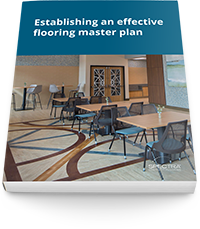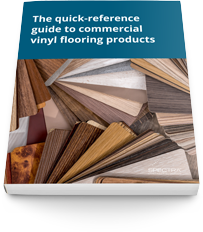Calculating the cost of a commercial vinyl flooring installation
When planning a flooring installation, you’ll probably consider the “look” of the material. You’ll likely consider the performance and durability. You’ll presumably consider the maintenance requirements.
But price? Well, that’s always going to be a factor in commercial flooring installations.
Facility managers and owners are choosing this durable and flexible material in more and more settings. And with that comes questions about installation cost.
Nothing beats a direct price comparison of fully completed bids. But we can lay out what you’ll generally expect to pay for:
- Vinyl sheet flooring
- Vinyl composition tile (VCT)
- Luxury vinyl tile (LVT)
We’ll also discuss influences on cost beyond material price and share guidance for evaluating bids.
All in all, this article will arm you with the information you need to make an informed choice for your budget — and save money on flooring in the long run.
(And for full definitions of each flooring type, how each is made and the traditional application uses, check out this commercial vinyl flooring primer.)
How much does commercial vinyl flooring cost per square foot?
The figures below will give you and your team a general expectation of costs. Prices will of course vary depending on the manufacturer, design options and so on — but this is a great place to get a sense of your investment.

How much will vinyl sheet flooring cost?
Material cost per square foot: $1 to $2
Difficulty of installation: High
Difficulty of maintenance: Medium to High
Majority of the time, sheet vinyl flooring is chosen for medical facilities and hospital settings because of its seamless, anti-microbial properties. The seams are heat-welded to prevent falls, moisture damage and bacterial growth. Additionally, designs can include bold colors and realistic patterns.
While the raw material cost can make sheet vinyl appear like a less expensive option, you should note the high difficulty of installation. Flooring installers must heat-weld the seams to prevent excessive dirt from building up in cracks and crevices — all in all, it’s labor intensive to install, thus driving up the overall price. It is, however, a more cost-efficient option when compared to rubber flooring for medical facilities.
Further, the lack of seams will make maintenance more difficult. If a part of the sheet vinyl is damaged, the entire section must be replaced, requiring more time and labor than simply swapping a tile.
The bottom line: It’s expensive to install and maintain, but can meet the sanitary needs of medical facilities.

How much will VCT cost?
Material cost per square foot: $3 to $5
Difficulty of installation: Medium
Difficulty of maintenance: High
VCT is a functional and durable commercial flooring option. It most often finds its way into school settings, warehouses and other high-traffic applications like office break rooms. Of these three commercial vinyl flooring options, VCT is the least expensive to purchase and install and is an excellent choice when upfront material costs are a primary concern.
However, VCT’s extensive cleaning requirements include regular stripping, waxing and polishing. This high difficulty of maintenance can lead to increased lifetime costs. And while VCT comes in a variety of colors and patterns, it doesn’t meet the same level of texture and design versatility available in LVT tiles or vinyl sheet.
The bottom line: A durable option with a lower upfront investment, but come prepared for regular (and intensive) maintenance.

How much will LVT cost?
Material cost per square foot: $5 to $10
Difficulty of installation: Low
Difficulty of maintenance: Low
Commercial LVT performs in high-end restaurant settings, residential and commercial tenant buildings, hospital lobbies — the benefits of LVT flooring have made it a popular vinyl flooring choice across applications.
It provides superior durability (wear layers make the material durable enough to withstand some of the most heavy-duty settings) and minimal maintenance (just regular vacuuming and dust mopping). Additionally, LVT offers superior design capabilities due to the versatility of its graphic layer. With LVT, you can mimic the look of rich hardwood flooring and premium stone finishes.
Commercial LVT will likely cost the most in the beginning because of raw material price. But the ease of installation, replacement and maintenance cuts down on your investment in the long run, not to mention less time required from your facilities team.
The bottom line: It’s an investment upfront, but the durable product will last and meet practically any design vision.
Think beyond material prices with lifecycle costing
You could end your pricing conversation right here now that you’ve been given the cost of the materials.
But you know that’s not the whole picture.
Lifetime investment should play a role in your cost comparison — after all, you’ll likely spend more money on maintaining a floor than on the initial purchase.

Establishing an effective flooring master plan
Is your flooring lasting its full lifespan? These industry-proven strategies help facility managers keep flooring systems clean, safe and reliable for years to come.
Consider this cost analysis conducted on floor coverings in school facilities. The study compared the lifetime costs (including materials, installation, re-installation, cleaning and maintenance) of VCT and carpet flooring over the course of two decades. And while the cost of carpet isn’t pertinent to our discussion of commercial vinyl flooring cost, this does demonstrate the tangible (i.e. dollar amount) results of long-term planning for a flooring system.
In both heavy-traffic areas and light-to-medium traffic areas, the total lifecycle cost of VCT exceeded that of the carpet over 22 years — even starting with the lower upfront material costs. (Check out pages 5 and 9 of the report for a detailed cost breakdown).
The good thing about lifecycle costing is that it’s a straightforward way to begin thinking about your project. When incorporating lifecycle costing into your vinyl material specifications, start by asking questions like:
- What are the different functions the space must support? For example, if you need infection and bacteria control, sheet vinyl may best suit your needs.
- How long will the facility be in use? If you only intend to use the space for a couple years — as with businesses leasing a property — or upfront costs are a big concern, VCT is a great option.
- What kind of wear and tear will the space see? All three vinyl options are built for durability, with sheet vinyl of course leading in aseptic applications.
- What look is the client trying to achieve? And if a high-end look is important, LVT’s ability to mimic practically any material could come in handy.
For more guidance on how to incorporate lifecycle costing into your flooring project, read this article.
Other ways to keep costs down
Streamlining commercial grade vinyl flooring cost can take many forms — and it doesn’t just need to include double- or triple-checking the material cost-per-square-foot calculations.
You can also keep an eye out for these “red flags” on a flooring bid. They might not add to the initial project cost, but the price of these potential mistakes can end up costing you and your facility in the long run.
Red flag #1: A flooring contractor without financial backing
Partnering with a flooring contractor that has strong financial backing is necessary for any sizable project. It means your contractor can invest in your project and not get slowed down due to cash-flow needs.
If you ask, your contractor should be able to show you proof. One metric is bonding capacity, which is similar to insurance. It provides financial backing to assure owners of a contractor’s ability to deliver a project.
How this saves you money: If your project isn’t forced to be put on hold due to cash-flow concerns, that keeps your installation on-schedule and thus more likely to stay on-budget.
Red flag #2: A bid that doesn’t account for adhesive removal
Certain flooring adhesives aren’t compatible with each other; this poses a problem on renovation jobs where one adhesive was used on the original and a different adhesive is used on the new flooring system.
For example, PVC backing is incompatible with latex adhesive. If you replace a latex-backed broadloom carpet with PVC-backed carpet tile, the latex adhesive should be removed or treated prior to installing the new floor covering. If left untreated, the PVC backing will break down over time and residue will come up from the tile joints, creating an unsightly mess and diminishing the integrity of the flooring system.
How this saves you money: A bid that includes prep time and budget for removing incompatible adhesives means you won’t have any unexpected costs that pop up mid-project.
Red flag #3: An inexperienced installation team
Learning how your potential contractor will conduct the job is a good indicator of a quality bid. This isn’t as obvious as a line item on a flooring bid, but a few questions will help you determine their commitment to their work.
Ask questions like:
- What is your history with jobs of a similar size and scope?
- Who will be executing the job? And what training and safety certifications have they passed?
- Are you manufacturer-certified to install the materials?
- What logistics support do you have?
How this saves you money: By vetting these qualifications early in the bid stage, you’ll set your project up for success. A poorly executed installation job could mean a sooner-than-expected replacement, safety issues like trip hazards, aesthetics that don’t match your facility’s standards — and the list goes on. Avoiding any and all of these issues is better for your bottom line.
For more low bid red flags and other guidance for evaluating flooring bids, check out this guide.
Ready to discuss specifics?
We’ve given you the foundational knowledge to understand what can influence the cost of a vinyl flooring project.
That’s a great first step — the next involves talking to a flooring expert.
From there, we’ll be able to get into the specifics of your flooring project. Our team has completed over 400,000 installation projects (including lots of commercial vinyl) and will take you through the design, durability and, most importantly, cost of your new flooring system. Start a conversation with a flooring expert.

Reference guide to commercial vinyl flooring products
Take the guesswork out of vinyl product selection. This guide cuts through the noise, offering you quick takeaways about the pros, cons, price and performance of LVT, VCT and vinyl sheet flooring.
